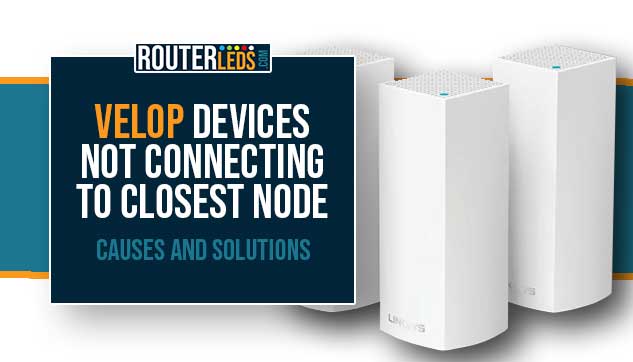Are you experiencing issues with your Linksys Velop mesh system? Have you noticed your Velop devices not connecting to the closest node?
In this article, we are going to check the reasons why your Velop devices might not be connecting to the closest node. We will also explain how to troubleshoot this issue step-by-step.
With a little effort, you can restore your Velop mesh system’s performance and enjoy seamless Wi-Fi coverage throughout your home.
Understanding The Linksys Velop Mesh System

The primary role of the Linksys Velop mesh system is to provide seamless Wi-Fi coverage throughout your home. The Velop mesh system consists of a primary node that is connected directly to the modem and secondary nodes strategically positioned in your living space. The system automatically routes your devices to the closest node, ensuring optimal network performance.
However, from time to time your Velop devices might not connect to the closest node. This leads to slower Wi-Fi speeds and poor network performance. Let’s see what are the most frequent reasons for this issue and how to fix it.
Common Causes For Connection Issues
There are several different reasons why your Velop devices are not connecting to the closest node. Here are the most common ones:
- Incorrect Node Placement – Heavy obstacles and a great distance between nodes are the most common reason.
- Interference –Interference from other electronic devices or building materials.
- Firmware Issues – Outdated or corrupted firmware can also cause connection issues with your Velop devices
Troubleshooting Connection Issues: Step-by-Step
Reevaluate Node Placement
Make sure the nodes are optimally placed within your home to maximize Wi-Fi coverage. Consider the following:
- The ideal distance between nodes should be around 30 to 50 feet. Try moving the problematic node closer to a node with a blue light.
- If possible, remove large furniture or appliances that could interfere with the signal or reposition the node instead.
- You can also place the node in a higher position to make sure other objects are not blocking them.
Minimize Interference
Interference from other electronic devices is another reason for most Linksys node connection issues. In order to minimize this interference, try the following:
- Identify the potential sources of interference (cordless phones, microwaves, baby alarms and so on) and place them or the node away from each other.
- If there are areas with dense building materials like concrete or metal you can pace the nodes in a better position.
- Change your router’s channel settings to avoid overlapping with other nearby Wi-Fi networks. The Linksys app has a Channel Finder feature that can automatically find the best channel for you.
Update Firmware
Don’t forget to check the node and primary node firmware and update if necessary. You can follow these steps to do it properly:
- Access the Linksys app or web interface and navigate to the firmware update section.
- Linksys App: Select Network Administration in the menu. Tap on each node to check the firmware version. If you have the latest firmware version installed, you will see an Up to date label.
- Web Based Interface: Login to your Linksys Velop device, click on Device List, and then select the nodes one by one to check the firmware version. If you have the latest firmware version installed, you will see an Up to date label.
- Check for available updates and install them as needed.
- Reboot the nodes after the update for the changes to take effect.
Perform A Network Assessment
You probably have the Linksys app installed on your smartphone so use it to perform a network assessment and adjust some of the settings if necessary:
- Open the Linksys app and navigate to the network assessment tool.
- Follow the on-screen instructions to perform the assessment.
- Analyze the results and make any necessary adjustments to your network settings, such as changing Wi-Fi channels or adjusting node placement.
Contact Support
In the end, if nothing helps, it is recommended to contact Linksys support for further assistance.
By following these troubleshooting guidelines, you can effectively address connection issues with your Velop devices and restore optimal network performance.
Frequently Asked Questions
You can use the Linksys app to view the connected devices and their corresponding nodes. The app will display the devices connected to each node. This will help you confirm that the device is connected to the closest node.
The Velop system is designed to automatically route your devices to the closest node for optimal performance. At the moment, there is no option to assign a specific node to a device manually.
No, a Velop system requires only one primary node connected to your modem. The remaining nodes are secondary nodes, which extend the Wi-Fi coverage throughout your home.
The number of secondary nodes you can add to your Velop system depends on the specific Velop model you own. Most Velop systems can support up to five nodes in total (including the primary node). However, some models may allow for more nodes. Please refer to your Velop product documentation for specific information.
Conclusion
In the end, we can say that if your Velop devices are not connecting to the closest node, the most possible reasons are incorrect node placement, interference, or firmware issues. The steps described in this article should help you fix this issue pretty quickly. However, if nothing helps you can always get in touch with Linksys support for further assistance.

